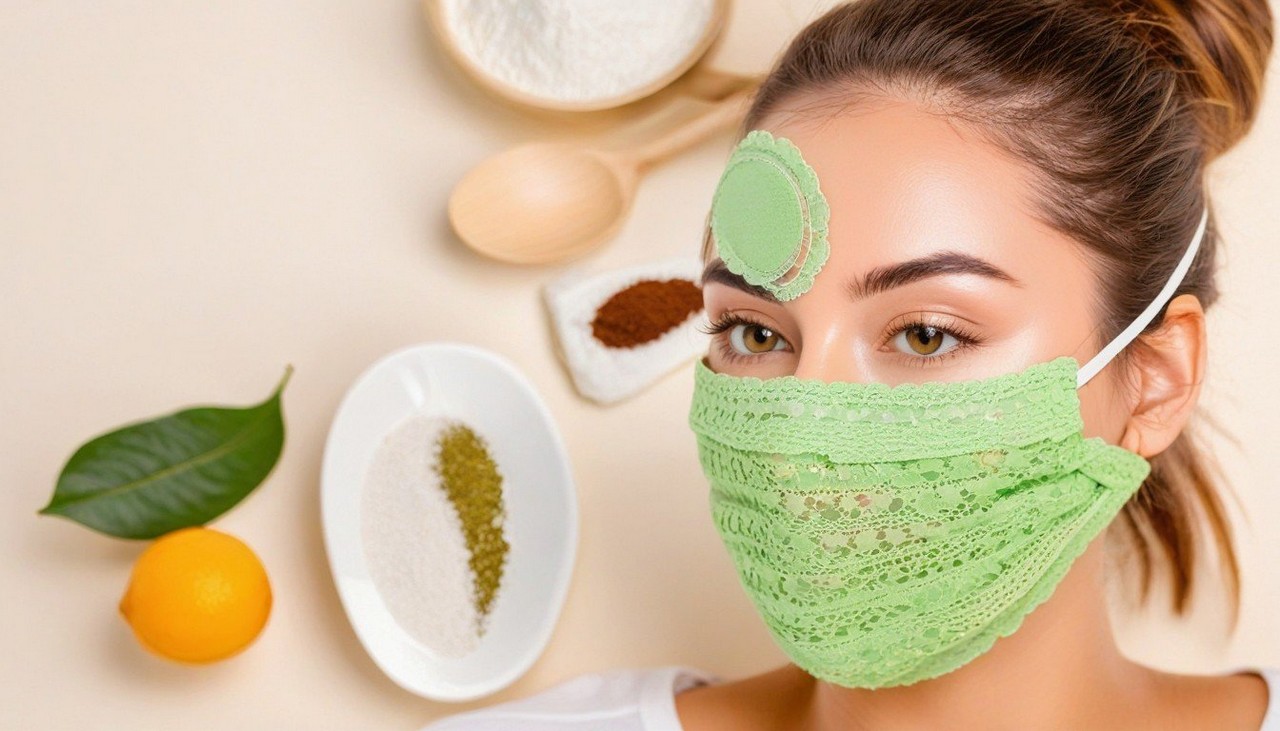As a skincare enthusiast, I have always been intrigued by the idea of creating my face masks. Not only are DIY face masks a fun and creative way to pamper yourself, but they also allow you to customize the ingredients based on your specific skin type and concerns. In this step-by-step tutorial, I will guide you through the process of creating the perfect DIY face mask for your skin type.

Benefits of Using DIY Face Masks
Before we dive into the nitty-gritty of creating DIY face masks, let’s take a moment to discuss the benefits. One of the major advantages of DIY face masks is that you have full control over the ingredients. Commercial face masks often contain harsh chemicals and preservatives that may not be suitable for everyone. By making your masks, you can ensure that only natural and beneficial ingredients are being applied to your skin.
Another benefit of DIY face masks is their cost-effectiveness. Most homemade face masks require ingredients that can be found in your kitchen pantry or local grocery store. This means you can achieve glowing skin without breaking the bank. Additionally, DIY face masks can be a great way to relax and unwind after a long day. The process of mixing and applying the mask can be therapeutic, allowing you to take some time for self-care.
Determining Your Skin Type
Before you start creating your DIY face mask, it’s important to determine your skin type. This will help you identify the specific needs of your skin and select the right ingredients. There are generally four main skin types: oily, dry, combination, and sensitive.
If your skin tends to look shiny and greasy throughout the day, you likely have oily skin. On the other hand, if your skin feels tight and appears flaky, you have dry skin. Combination skin is characterized by an oily T-zone (forehead, nose, and chin) and dry cheeks. Lastly, sensitive skin is easily irritated and may react to certain ingredients or environmental factors.
Choosing the Right Ingredients for Your Skin Type
Now that you have determined your skin type, it’s time to choose the right ingredients for your DIY face mask. Here are some suggestions based on each skin type:
- Oily Skin: Clay (such as bentonite or kaolin), tea tree oil, lemon juice, and witch hazel are excellent for controlling excess oil and preventing breakouts.
- Dry Skin: Avocado, honey, yogurt, and almond oil are hydrating ingredients that can nourish and moisturize dry skin.
- Combination Skin: Aloe vera, cucumber, green tea, and jojoba oil are suitable for balancing oil production in the T-zone while providing hydration to the rest of the face.
- Sensitive Skin: Chamomile, oatmeal, coconut oil, and rosehip oil are gentle ingredients that soothe and calm sensitive skin without irritating it.
Remember, these are just a few examples, and you can always experiment with different ingredients to find what works best for your skin.
Step-by-Step Guide to Creating a DIY Face Mask
Now that you have all the necessary information, let’s dive into the step-by-step process of creating a DIY face mask:
- Start by gathering the ingredients and tools you will need. This includes a mixing bowl, a spoon or spatula for mixing, and the chosen ingredients based on your skin type.
- Cleanse your face thoroughly to remove any dirt or makeup residue. This will ensure that the mask can penetrate deeply into your pores.
- Measure out the ingredients according to the recipe you have chosen. It’s important to follow the measurements to maintain the right consistency of the mask.
- Combine the ingredients in the mixing bowl and mix well until you have a smooth and uniform paste. You can use a spoon or spatula to do this.
- Apply the mask to your face using clean fingers or a brush. Start from the centre of your face and work your way outwards, avoiding the eye and lip area.
- Leave the mask on for the recommended time. This can vary depending on the ingredients used, but most DIY face masks are left on for 10-15 minutes.
- Gently rinse off the mask with warm water. Use circular motions to massage the mask off your face, taking advantage of its exfoliating properties.
- Pat your face dry with a clean towel and follow up with your regular skincare routine, such as applying a toner and moisturizer.
Tips for Applying and Removing the Face Mask

To ensure the best results, here are some tips for applying and removing your DIY face mask:
- Always start with a clean face. This will allow the mask to penetrate better and maximize its benefits.
- Apply the mask evenly, making sure to cover the entire face. Avoid applying it too close to the eyes or mouth to prevent irritation.
- Use gentle and upward strokes when applying the mask. This can help promote circulation and lymphatic drainage.
- Don’t leave the mask on for longer than recommended. Leaving it on for too long can cause dryness or irritation.
- Remove the mask with warm water and avoid scrubbing too harshly. Be gentle to prevent any damage to your skin.
- Follow up with a moisturizer to lock in the benefits of the mask and keep your skin hydrated.
Additional Skincare Tips for Maintaining Healthy Skin
While DIY face masks can work wonders for your skin, it’s important to incorporate other skincare habits to maintain healthy skin. Here are some additional tips:
- Cleanse your face twice a day to remove dirt, oil, and impurities.
- Exfoliate regularly to remove dead skin cells and promote cell turnover.
- Use sunscreen daily to protect your skin from harmful UV rays.
- Stay hydrated by drinking plenty of water throughout the day.
- Follow a balanced diet rich in fruits, vegetables, and healthy fats.
- Get enough sleep to allow your skin to repair and rejuvenate itself.
Remember, skin care is a holistic process, and combining these tips with your DIY face masks can help you achieve radiant and healthy skin.
DIY Face Mask Recipes for Different Skin Types
Now that you have all the knowledge and tips, it’s time to try out some DIY face mask recipes tailored to your skin type. Here are a few recipes to get you started:
- For Oily Skin:
- Ingredients: 1 tablespoon bentonite clay, 1 teaspoon tea tree oil, 1 teaspoon lemon juice, 1 tablespoon witch hazel.
- Mix all the ingredients in a bowl until you have a smooth paste.
- Apply the mask to your face and leave it on for 10-15 minutes.
- Rinse off with warm water and pat dry.
- For Dry Skin:
- Ingredients: 1/2 ripe avocado, 1 tablespoon honey, 1 tablespoon yoghurt, 1 teaspoon almond oil.
- Mash the avocado in a bowl until smooth.
- Add honey, yoghurt, and almond oil to the mashed avocado and mix well.
- Apply the mask to your face and leave it on for 10-15 minutes.
- Rinse off with warm water and pat dry.
- For Combination Skin:
- Ingredients: 2 tablespoons aloe vera gel, 1/4 cucumber (blended), 1 teaspoon green tea powder, 1 teaspoon jojoba oil.
- Mix all the ingredients in a bowl until well combined.
- Apply the mask to your face and leave it on for 10-15 minutes.
- Rinse off with warm water and pat dry.
- For Sensitive Skin:
- Ingredients: 1 tablespoon chamomile tea (cooled), 1 tablespoon oatmeal (ground), 1 teaspoon coconut oil, 1 teaspoon rosehip oil.
- Combine all the ingredients in a bowl and mix well.
- Apply the mask to your face and leave it on for 10-15 minutes.
- Rinse off with warm water and pat dry.
Feel free to experiment with these recipes and adjust the ingredients according to your preference and skin’s needs. Remember to always patch-test new ingredients before applying them to your entire face.
Frequently Asked Questions about DIY Face Masks

- Are DIY face masks safe for all skin types?DIY face masks can be safe for all skin types as long as you choose the right ingredients and follow the instructions carefully. However, individuals with sensitive skin should be cautious and do a patch test before applying the mask to their entire face.
- How often should I use a DIY face mask? The frequency of using a DIY face mask depends on your skin type and the ingredients used. As a general rule, it’s recommended to use a face mask once or twice a week. However, if you have sensitive skin, it’s best to start with once a week and gradually increase the frequency if your skin tolerates it well.
- Can I store leftover DIY face masks? It’s best to use the DIY face mask immediately after preparing it to maximize its freshness and effectiveness. Storing leftover masks can lead to bacterial growth and reduce their potency. If you do have any leftovers, discard them and make a fresh batch for your next application.
- Can I combine different DIY face mask recipes? While it’s possible to combine different DIY face mask recipes, it’s important to ensure that the ingredients are compatible and suitable for your skin type. Experimenting with different combinations can be fun, but always be mindful of how your skin reacts and adjust accordingly.
Conclusion and Final Thoughts
Creating your DIY face masks is not only a cost-effective way to care for your skin but also an opportunity to customize your skincare routine. By determining your skin type, choosing the right ingredients, and following a step-by-step guide, you can create a face mask that addresses your specific needs.
Remember to always prioritize the health and safety of your skin by patch-testing new ingredients, following proper application and removal techniques, and maintaining a consistent skincare routine. With a little experimentation and self-care, you can discover the perfect DIY face mask for your skin type and enjoy the benefits of healthy and glowing skin.
Now, it’s time to embark on your DIY face mask journey and indulge in some well-deserved pampering. Your skin will thank you!
CTA: Treat your skin to a luxurious DIY face mask today and experience the benefits of natural ingredients tailored to your specific skin type. Start by determining your skin type, selecting the right ingredients, and following our step-by-step tutorial. Your skin deserves the best, and with DIY face masks, you can achieve a healthy and radiant complexion. Get creative, have fun, and discover the perfect DIY face mask for you!
